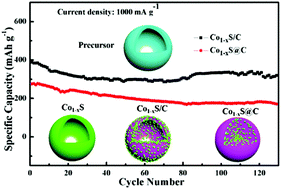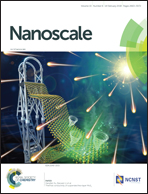Ultrafine Co1−xS nanoparticles embedded in a nitrogen-doped porous carbon hollow nanosphere composite as an anode for superb sodium-ion batteries and lithium-ion batteries†
Abstract
Cobalt sulfides are attractive as intriguing candidates for anodes in SIBs and LIBs owing to their unique chemical and physical properties. In this study, a precursor of Co1−xS with a uniform and hollow nanospherical architecture is obtained with a high yield via a mild solvothermal method in the presence of 2-methylimidazole at first. Then, Co1−xS, Co1−xS/C (ultrafine Co1−xS nanoparticles embedded in the shells of the nitrogen-doped porous carbon hollow nanosphere), and Co1−xS@C (Co1−xS nanoparticles entirely covered by an external amorphous carbon layer) were selectively fabricated via direct calcination or PPy coating & calcination of the obtained precursor. Co1−xS/C shows best electrochemical performance than the other two materials as anodes for sodium-ion batteries (SIBs). Besides the excellent rate performance, a high reversible discharge capacity of 320 mA g−1 can be retained after 130 cycles at 1 A g−1. The impressive performance may be attributed to the unique structure, higher conductivity, and more active sites of Co1−xS/C. In addition, 559 mA h g−1 was maintained after 100 cycles at 500 mA g−1 when the Co1−xS/C composite was applied as an anode in lithium-ion batteries (LIBs). The high reversible capacity, excellent cycle stability combined with the facile synthesis procedure render Co1−xS/C a prospective anode material for rechargeable batteries.



 Please wait while we load your content...
Please wait while we load your content...